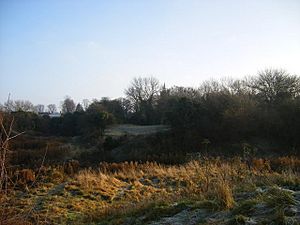Burwell Castle facts for kids
Quick facts for kids Burwell Castle |
|
|---|---|
| Burwell, Cambridgeshire, England | |

Earthwork remains of Burwell Castle
|
|
| Coordinates | 52°16′09″N 0°19′28″E / 52.2693°N 0.3244°E |
| Type | Enclosure castle |
| Site information | |
| Owner | Burwell Parish Council |
| Condition | Earthworks |
Burwell Castle was a medieval castle in Burwell, Cambridgeshire, England. It was never fully finished.
Contents
Burwell Castle: A Story of an Unfinished Fortress
Building a Castle in Troubled Times
Burwell Castle was started in 1143 by King Stephen I of England. It was built near the village of Burwell, on the site of an old Roman villa. At this time, England was going through a civil war called the Anarchy. This was a long fight between King Stephen and his rival, the Empress Matilda, over who should rule England.
A powerful baron named Geoffrey de Mandeville had lost his castles to King Stephen. He started a rebellion and set up his base near Ely. He was a threat to Cambridge Castle and the main road to London. So, King Stephen decided to build a series of castles to protect the area. Burwell Castle was one of these important forts. Other castles were built at Lidgate, Rampton, Caxton, and Swavesey.
King Stephen took over the village of Burwell, which was on a raised area of land from Roman times. Then, he began building the castle. The castle was designed as a rectangular mound, about 60 by 30 meters in size. It was surrounded by a wide ditch, up to 30 meters across.
The Attack and What Happened Next
In 1144, Geoffrey de Mandeville attacked Burwell Castle. The castle was still being built at the time. During the attack, Geoffrey was hit by a crossbow bolt. He had to leave the battle and went to nearby Mildenhall. Sadly, he died from his injury there.
After Geoffrey's death, Burwell Castle was never completed. However, a stone gatehouse was built on the site. This suggests that people continued to use the area for some time. Around 1246, the Abbot of Ramsey built a chapel there. The castle site was finally left empty in the 15th century.
What Remains Today
In 1935, an archaeologist named T. C. Lethbridge dug up parts of the site. At that time, some stone walls were still standing. But these walls were later destroyed during a fire hose test.
The Burwell Parish Council bought the castle site in 1983. In the 2010s, the University of Exeter studied the castle using special equipment to map the ground. Today, only the unfinished earthworks of the castle remain. These earthworks are protected as a scheduled monument, which means they are important historical sites.



